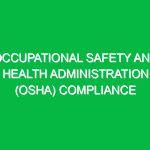Introduction to Hazardous Material Handling
Hazardous material handling refers to the processes associated with the management, storage, and disposal of substances that can pose a threat to health, safety, or the environment. This concept is especially significant in the Health, Safety, and Environment (HSE) domain, where the focus is on mitigating risks and ensuring compliance with regulations. Whether in a manufacturing plant, a laboratory, or a construction site, understanding how to handle hazardous materials is critical to the safety and well-being of employees, the public, and the environment.
The relevance of hazardous material handling is underscored by the potential consequences of mishandling these substances. Real-life incidents, such as the chemical spill at the DuPont facility in La Porte, Texas, in 2014, illustrate the devastating results of inadequate safety measures. An explosion killed four workers and exposed countless others to toxic substances, leading to long-lasting environmental damage and significant financial repercussions for the company. Such events highlight the imperative for robust training and compliance in hazardous material handling.
Identifying Hazards and Risks in Hazardous Material Handling
When discussing hazardous materials, it is essential to recognize the types of hazards involved. These can broadly be categorized into chemical, biological, physical, and environmental hazards.
Chemical Hazards
Chemical hazards are perhaps the most well-known risks associated with hazardous material handling. These include substances that are flammable, reactive, corrosive, or toxic. For instance, a worker transporting acids without proper personal protective equipment (PPE) risks severe chemical burns or respiratory issues. The National Institute for Occupational Safety and Health (NIOSH) reports that exposure to hazardous chemicals results in thousands of workplace injuries annually.
Biological Hazards
Biological hazards include microorganisms such as bacteria, viruses, and fungi that can cause illnesses. Laboratories often handle biological materials, such as blood samples or cultures, which require stringent protocols to prevent contamination and exposure. A hypothetical scenario involves lab technicians who neglect to use biosafety cabinets when handling infectious agents, potentially leading to outbreaks.
Physical Hazards
Physical hazards encompass risks such as spills, leaks, or explosions that can occur during the handling of hazardous materials. For example, inadequate containment measures might lead to a solvent spill, posing not only a health risk to employees but also a significant environmental threat.
Environmental Hazards
Environmental hazards arise from the improper disposal of hazardous materials. Landfills that accept toxic substances can leach harmful chemicals into groundwater, affecting local ecosystems. A case study from Love Canal in New York reveals how improper waste management led to severe health issues in residents, emphasizing the importance of responsible hazardous material handling.
Safety Precautions and Best Practices
To mitigate risks associated with hazardous material handling, organizations must implement comprehensive safety precautions and best practices. Here are several key strategies:
1. Proper Training
Training employees on hazardous material handling is paramount. A well-structured training program should cover topics such as recognizing hazardous materials, understanding Material Safety Data Sheets (MSDS), and using PPE correctly. Engaging training sessions that include real-life scenarios can enhance retention and awareness.
2. Implementation of Safety Protocols
Establishing standard operating procedures (SOPs) for handling hazardous materials is crucial. These protocols should detail steps for safe storage, usage, and disposal of hazardous substances. For instance, using secondary containment systems can prevent spills during the transfer of liquids.
3. Use of Personal Protective Equipment (PPE)
Wearing appropriate PPE is a non-negotiable aspect of hazardous material handling. This includes gloves, goggles, respirators, and protective clothing. A personal anecdote from a safety officer highlights the importance of PPE: during a routine inspection, a technician suffered a minor chemical splash due to a moment of negligence. Fortunately, their goggles prevented serious injury.
4. Regular Audits and Inspections
Conducting regular audits and safety inspections helps identify potential hazards before they escalate. These assessments can also gauge the effectiveness of existing safety measures and training programs. Organizations should encourage a culture of safety where employees feel empowered to report potential hazards without fear of reprisal.
5. Emergency Response Planning
An effective emergency response plan can mean the difference between a minor incident and a full-blown disaster. Organizations should prepare for potential emergencies, including spills or exposures, by conducting drills and maintaining readily accessible emergency equipment, such as eyewash stations and spill kits.
Regulations and Standards Governing Hazardous Material Handling
In the realm of hazardous material handling, several regulations and standards apply to ensure safety and compliance. Understanding these regulations is essential for organizations that handle hazardous materials.
Occupational Safety and Health Administration (OSHA)
OSHA sets the framework for workplace safety in the United States. They have established regulations, such as the Hazard Communication Standard (HCS), which requires employers to inform employees about the hazards of chemicals they might encounter. This includes maintaining accurate labels and MSDS for all hazardous materials.
Environmental Protection Agency (EPA)
The EPA governs the management of hazardous waste through the Resource Conservation and Recovery Act (RCRA). This legislation outlines how hazardous waste should be treated, stored, and disposed of, ensuring that environmental safety standards are met. For instance, facilities that produce hazardous waste must obtain permits and adhere to strict disposal guidelines.
International Standards Organization (ISO)
Internationally, the ISO 45001 standard provides a framework for occupational health and safety management systems. This standard emphasizes proactive risk assessment and continual improvement in safety practices, making it relevant for organizations dealing with hazardous materials.
Conclusion
Hazardous material handling is a critical aspect of ensuring health, safety, and environmental protection in various industries. By understanding the hazards associated with these materials, organizations can implement effective safety measures, comply with regulations, and foster a culture of safety. The stakes are high; the potential for accidents and environmental harm underscores the importance of diligence in hazardous material handling.
Through proper training, adherence to safety protocols, and commitment to continuous improvement, organizations can safeguard their employees and the environment. The lessons learned from past incidents serve as a reminder that effective hazardous material handling is not just about compliance—it’s about protecting lives and preserving the planet for future generations.


